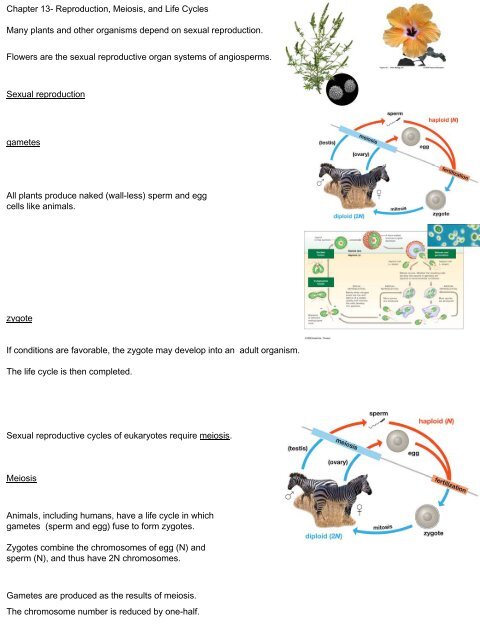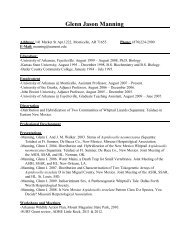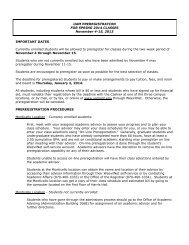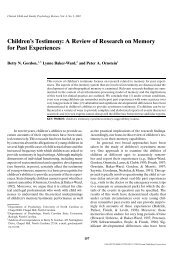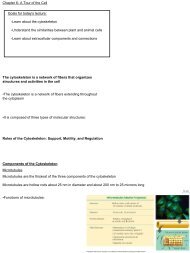Chapter 13- Reproduction, Meiosis, and Life Cycles Many plants ...
Chapter 13- Reproduction, Meiosis, and Life Cycles Many plants ...
Chapter 13- Reproduction, Meiosis, and Life Cycles Many plants ...
Create successful ePaper yourself
Turn your PDF publications into a flip-book with our unique Google optimized e-Paper software.
<strong>Chapter</strong> <strong>13</strong>- <strong>Reproduction</strong>, <strong>Meiosis</strong>, <strong>and</strong> <strong>Life</strong> <strong>Cycles</strong><strong>Many</strong> <strong>plants</strong> <strong>and</strong> other organisms depend on sexual reproduction.Flowers are the sexual reproductive organ systems of angiosperms.Sexual reproductiongametesAll <strong>plants</strong> produce naked (wall-less) sperm <strong>and</strong> eggcells like animals.zygoteIf conditions are favorable, the zygote may develop into an adult organism.The life cycle is then completed.Sexual reproductive cycles of eukaryotes require meiosis.<strong>Meiosis</strong>Animals, including humans, have a life cycle in whichgametes (sperm <strong>and</strong> egg) fuse to form zygotes.Zygotes combine the chromosomes of egg (N) <strong>and</strong>sperm (N), <strong>and</strong> thus have 2N chromosomes.Gametes are produced as the results of meiosis.The chromosome number is reduced by one-half.
Sexual reproduction in eukaryote is characterized bygametes, a zygote, <strong>and</strong> meiosis.<strong>Meiosis</strong>, the Basis of Sexual <strong>Reproduction</strong>Sexual reproduction does not produce geneticallyidentical replicas of the parents.In sexual reproduction, each offspring inherits a uniquecombination of genes from its two parents.As a result, sexual reproduction can produce greatvariation among offspring.The Process of <strong>Meiosis</strong><strong>Meiosis</strong> I-ChromosomesduplicateHomologouschromosomespair <strong>and</strong> exchangegeneticmaterialTetrads line upPairs of homologouschromosomes split upTwo haploid cells form;chromsomes are still double(sister chromatids are stillnot separated).<strong>Meiosis</strong> II- Sister chromatids separateChromosomesare not duplicated.Chromosomesline up in thecenter ofthe cellsSister chromatidsare pulled tothe poles ofthe cellsFour haploiddaughter cellsresult with singlechromosomes.
The Process of <strong>Meiosis</strong>The number of chromosomes are halved, so each of thefour daughter cells resulting from meiosis have only halfas many chromosomes as the starting cell.diploid haploidExchange of genetic material between homologous chromosomes.<strong>Meiosis</strong> is essential to sexual reproduction<strong>Meiosis</strong> produces gametes with half the number ofchromosomes(haploid number, N) as the parentcell.The zygote that results from fertilization is then diploid (2N) again.Asexual reproductionOffspring produced by asexual reproductioninherit all of their chromosomes from a singleparent.Mitosis
Mitosis (Cell division)Chromosomesare duplicated.Chromosomesattach to mitoticspindleChromosomesline up in thecenter ofthe cellsSister chromatidsare pulled tothe poles ofthe cellsTwo diploiddaughter cellsidentical toparent cellMitosis <strong>and</strong> cytokinesis are the basis for populationgrowth of single-celled eukaryotes <strong>and</strong> bodydevelopment in multicelluar organisms.Location of mitosis versus meiosis in <strong>plants</strong>
Mitosis-produces daughter cells genetically identicalto the parent cell.-involves 1 division of the nucleus-produces 2 diploid cells<strong>Meiosis</strong>-yields genetically unique haploid daughtercells (cells with only one member of eachhomologous chromosome pair).-involves 2 nuclear <strong>and</strong> cytoplasmic divisions-produces 4 haploid cellsSexual reproduction is common among eukaryotes <strong>and</strong> widely present in:Sexual reproduction- disadvantagesit requires organisms to invest scarce resources <strong>and</strong> expend considerable energy toproduce gametes.Sexual reproduction-advantagesGenetic diversity -sexual reproduction combines the DNA of 2 different organisms (usually of the same species)<strong>and</strong> produces new combinations of valuable genetic traits.
Why do so many organisms also or exclusively reproduce asexually?Asexual reproduction-advantages-all the progeny are genetically alike (well, mostly),so the chances are good that many will surviveif the environment is stable <strong>and</strong> homogeneous.These advantages explain why asexual reproduction hascommonly evolved in nature.D<strong>and</strong>elions (Taraxacum officinale) <strong>and</strong> related species ofhawkweeds (Hieracium spp.) are examples of hundredsof <strong>plants</strong> that reproduce exclusively by seeds formedasexually.Asexual reproduction-disadvantagesAmong <strong>plants</strong>, there are many examples of species that reproduce by asexual <strong>and</strong> sexual means.Aspen trees (Populus tremuloides)These trees have been generated by asexual reproduction -development of young sapling shoots of horizontally growing roots ofparent trees.
<strong>Life</strong> cycles link one generation to the next<strong>Life</strong> cycleAsexual organismsSexual organismsThree basic types of sexual life cycles:-gametic-zygotic-sporicGametic life cycleThe reproductive cycle ofhumans <strong>and</strong> other animalsis the life-cycle that is probablymost familiar to you.All sexually reproducing modern animal groups have a gametic life cycle-It arose very early in evolutionary historyAdvantages of a gametic life cycleIf a gene on one homologous chromosome has a mutation, then the correspondinggene (allele) on the other homologous chromosome may be normal.If the environment changes, the variant geneform may be selected for, <strong>and</strong> give the organisma better chance of survival than the “normal” gene.
Zygotic life cycles-These organisms are haploid during most of theirlife cycleAdvantages of zygotic life cycles-Gametes can be produced quickly by mitosis.When environment conditions improves, zygotes undergo meiosis <strong>and</strong> producegenetically diverse progeny.Disadvantages of zygotic life cycles-Haploid organisms only have 1 set of chromosomes.-The organism has no “spare genes” to mask the effect of the mutation (no genetic redundancy).Sporic life cyclesAll <strong>plants</strong>, from bryophytes to flowering <strong>plants</strong>, as wellas some algae, have sporic life cycles known asalteration of generations.Sporic life cycles involve 2 types of multicellular bodies:-This contrast is a major difference between plant <strong>and</strong> animal reproductionThe gametophyte generates eggs <strong>and</strong> sperm by mitosis not meiosis.The zygote that results from fertilization grows into the plant sporophyte by repeated mitotic divisions.When sporophytes are mature, they produce spores by meiosis.
Plant groups differ in the relative sizes of the sporophyte <strong>and</strong> gametophyte.As l<strong>and</strong> <strong>plants</strong> evolved, the size of the haploidgametophyte became reduced, while the diploidsporophyte increased in size <strong>and</strong> became more important.In bryophytesIn bryophytes, the diploid sporophyte stage is small <strong>and</strong>dependent upon the gametophyte.Bryophytes are probably much like the earliest l<strong>and</strong>adapted<strong>plants</strong>.The later-appearing seed <strong>plants</strong> reduce the size of thehaploid gametophyte stages.
Study outline-<strong>Chapter</strong> <strong>13</strong>-<strong>Reproduction</strong>, <strong>Meiosis</strong>, <strong>and</strong> <strong>Life</strong> <strong>Cycles</strong>-Underst<strong>and</strong> sexual reproductionKnow terms-sexual reproduction, gametes, zygote, meiosis, [haploid (N) , diploid (2N) –Fig. <strong>13</strong>.3]Know general characteristics of sexual reproduction-meiosis is the cell division that is associated with sexual reproduction-sexual reproduction does not produce genetically identical replicas of parents-in sexual reproduction, each offspring inherits a unique combination of genes from its two parents-sexual reproduction can produce great variation among offspring-Underst<strong>and</strong> the process of meiosisKnow different stages of meiosis as described in Fig. <strong>13</strong>.12 IIa-j <strong>and</strong> overview in lecture.Underst<strong>and</strong> that meiosis is essential to sexual reproduction-meiosis produces gametes with half the number of chromosomes (haploid, N) as the parent cell-diploid haploid-the zygote that results from the fertilization of the two haploid (N) gametes is diploid (2N)-meiosis prevents the chromosomes from doubling in every generation-Underst<strong>and</strong> the process of mitosisKnow the different stages of mitosis as described in Fig. <strong>13</strong>.12 Ia-f <strong>and</strong> overview in lecture. If you need furtherreview of mitosis, read <strong>Chapter</strong> 7-Cell Division-pg. 124-129.-Underst<strong>and</strong> meiosis versus mitosis-Where does mitosis occur in the plant?-Where does meiosis occur in the plant?Mitosis-produces daughter cells genetically identicalto the parent cell.-involves 1 division of the nucleus-produces 2 diploid cells<strong>Meiosis</strong>-yields genetically unique haploid daughter cells (cellswith only one member of each homologous chromosomepair).-involves 2 nuclear <strong>and</strong> cytoplasmic divisions-produces 4 haploid cells-Compare sexual <strong>and</strong> asexual reproduction-Sexual reproduction is common in which groups of eukaryotes?-What are the disadvantages of sexual reproduction?-What are the advantages of sexual reproduction?-What are the disadvantages of asexual reproduction?-What are the advantages of asexual reproduction?-Name some organisms that reproduce asexually.-Underst<strong>and</strong> the importance of life cycles-Know term-life cycle, g-What are the general differences between the life cycles of asexual organisms <strong>and</strong> sexual organisms?-Know the three basic types of sexual life cycles-gametic, zygotic, <strong>and</strong> sporic-Be able to recognize <strong>and</strong> briefly summarize a gametic life cycle-(Fig. <strong>13</strong>.14b)-In general what types of organisms exhibit a gametic life cycle?-What are the advantages of a gametic life cycle?-Be able to recognize <strong>and</strong> briefly summarize a zygotic life cycle-(Fig. <strong>13</strong>.14c)-In general what types of organisms exhibit a zygotic life cycle?-What are the advantages <strong>and</strong> disadvantages of a gametic life cycle?-Be able to recognize <strong>and</strong> briefly summarize a sporic life cycle-(Fig. <strong>13</strong>.14d)-In general what types of organisms exhibit a sporic life cycle?-What are the main differences between gametic <strong>and</strong> sporic life cycles?-As l<strong>and</strong> <strong>plants</strong> evolved, how did the relationship between haploid (gametophyte) <strong>and</strong> diploid (sporophyte) change?


